- Home
- Deborah Harkness
The World of All Souls Page 31
The World of All Souls Read online
Page 31
Daemons and witches are spread throughout the city, their lodgings dependent on their socioeconomic status. Daemons tend to cluster around the Venetian arsenal or in the textile and art centers in the city. Some of the witches, such as Laura Malipiero, run small pensioni that cater to human tourists and their fellow witches, who overrun them around times such as carnival and the regatta.
The vampire elite, who have come out on top in the brutal power play of the city, own much grander lodgings. Matthew Clairmont, Baldwin Montclair, Gerbert d’Aurillac, and Domenico Michele (who was reborn there) have had palazzos in the city for centuries. Almost all those who were able to get into the real-estate market early have palazzos on the Grand Canal or just off it. These are very lavish, particularly Matthew’s house Ca’ Chiaromonte.
Ca’ Chiaromonte Palazzo, Grand Canal
Ca’ Chiaromonte was an appropriate dwelling for someone like Matthew who had played a pivotal role in Venetian business and political life for centuries. Its three floors, Gothic façade, and sparkling windows screamed wealth and status.
Diana was too preoccupied to appreciate the full beauty of Matthew’s Venetian residence on her first visit to the city. Its magnificent interiors, with lanternlike leaded bay windows overlooking the entrance to the Grand Canal, and rich red and gold decorations, illustrate the de Clermonts’ high standing in Venice. When the weather warms up, there is also the garden to sit in, with Matthew’s pet turtles fighting a losing battle to keep the mosquitoes at bay.
Ca’ Chiaromonte, or Chiaramonte House (named after the Italian translation of Clairmont), is based on the fifteenth-century Palazzo Falier. This was once the palace of Doge Marin Falier (or Marino Faliero), a notorious figure who, after being elected doge, plotted to take absolute power in the city. He paid the price for the coup’s failure and was beheaded in 1355 by the ruling aristocrats and Venetian senate. Today a black shroud still covers the space where his portrait should be in Venice’s Great Council Hall.
Palazzo Falier, Calle Vitturi o Falier, 2917a, 30124 Venice
I was in Venice for the first time doing location research for The Book of Life and had an intrepid native Venetian lady, Bruna, as my guide. Somehow she got us into Palazzo Falier, which remains privately owned and is not usually open to the public. As I was walking through the piano nobile, the impressive main floor, I spied this wonderful carved fireplace—with the motto of Francis I and Christopher Marlowe inscribed: WHAT NOURISHES ME DESTROYS ME. That was all the sign I needed that this should be the model for Matthew’s house in Venice. At the time of writing, you can rent a flat in the palazzo for your holiday and enter through the grand front door to reach it.
Isola della Stella
THE CONGREGATION HEADQUARTERS
The Congregation moved to Venice in 1453 following Constantinople’s fall to the advancing Ottoman navy. Members brought books, precious objects, and records of creature history to the city and purchased an island in the lagoon from the Catholic Church: Isola della Stella (Island of Stars). On it were monastic buildings that were converted to suit the Congregation’s purposes. The original character has remained in the place where they still meet today; the hushed cloisters and the well at the center that once supplied water to those staying there; large, high-ceilinged halls; the vast, ancient monastery library filled with books, papers, and papyri; the Congregation’s meeting chamber (Cella de Novem), a nonagon-shaped room with a domed roof where the nine members of the creature council sit. This council chamber, with its stunning frescoes, mosaics, vaulted ceiling, and gallery where the most precious records are kept, embodies the Congregation’s power. The large oval table at its center is surrounded by high-backed chairs, each marked with specific symbols, the de Clermont ouroboros among them.
The island is protected by powerful magic to turn away prying human eyes, and witches bound powerful spirits to the island to serve as its security force. There are far fewer creatures on the island in the present time than there were in 1453, and only a handful of permanent staff run the place. Congregation members and their personal attendants are welcome there at any time as they conduct official business. Small rooms are available for them, really just converted monastic cells that were once necessary refuges for creatures during time of plague, war, and bad weather. Today most members of the Congregation prefer to reside in their Venetian palazzos or personal lodgings when they are called to town for formal council meetings or to do other business, shuttling back and forth between Venice and the remote island by vaporetto.
There was no single inspiration for the Isola della Stella. Instead it was stitched together from the legends and history of two islands in the Venetian lagoon. One is Poveglia, with its octagonal fort and haunted past. It is now uninhabited but once was used to quarantine plague victims. The other is the island of San Francesco del Deserto, which is still home to a handful of monks.
See also: ORGANIZATIONS: The Congregation
Magic
The magic in the All Souls world spans the breadth of magical possibilities. Witches wield their power in two different ways: magic and witchcraft. Magic is power that a witch simply has and can apply as she or he likes to the elemental world—it is in the heart, not the mind, and is tied to desire. Witchcraft, on the other hand, uses words woven into spells to shape a witch’s power. Some witches, like Sarah Bishop, are more skilled in the craft; others, like Emily Mather, are stronger in elemental magic. Stephen Proctor describes elemental magic as the warp—the strong fibers that make up the world—and the spells of the craft as the weft. They’re both part of one big system.
Much of the practice of magic is related to objects and to the working of spells. Most witches use spells devised by other witches, and these spells are passed down through families in a cherished grimoire, a sort of cookbook for magic. In spells, there is an underlying theory of knot magic that uses the threads of the world to bind and unbind specific powers. These knots are magically embedded in words and ritual, and when a witch recites a spell, it activates these hidden powers.
Every witch has some connection to one of the four elements—earth, air, fire, and water—with most witches having an affinity for earth that provides the basics of herbal magic and the use of spells. Other magical powers linked to the elements include precognition (air), flight (air), finding things that are lost (earth), talking with the dead (earth), transmogrification (water), telekinesis (fire), spell casting (earth), charms (earth), curses (fire), mind reading (fire), telepathy (air) and empathy (fire). Sadly, there is no witchcraft that can heal vampire bites.
Like science, magic is not a set of big concepts or trickery but a way of living, a mode of working, a knowledge that must be mastered and developed. Magic is the equal to science. One is not better, or truer, than the other; both are technologies of power used in different ways.
Diana Bishop tried to deny this magical side of herself and her own central position in the world of witches and magic. But opening Ashmole 782 in the Bodleian and meeting Matthew Clairmont made it impossible for her to ignore those aspects of her identity any longer. For Diana there was no denying her nature. Just as the ribbons of her mother’s spellbinding fell away, so the magical possibilities that make up the world of All Souls were unraveled and Diana gradually learned how to harness her unique power. By tracking her growth and examining all aspects of the world she inhabits, we can understand more fully the magical threads that make up Diana Bishop, weaver and witch.
Magic and Witchcraft: The World of Diana Bishop
The Goddess: Maiden, Mother, and Crone
Diana’s family and fellow witches worship the goddess as a threefold deity composed of the maiden, the mother, and the crone. The maiden represents birth and youth and is symbolized by the waxing moon. The mother represents fertility and power and is symbolized by the full moon. The crone represents wisdom, death, and endings and is symbolized by the waning moon. Each of these representa
tions is identified with a particular Greek moon goddess: Artemis (the Greek version of Diana) for the maiden; Selene for the mother, because she was the mother of Endymion’s children; and Hecate for the crone, because she is associated with the underworld and magic.
The witchcraft in the All Souls world is a combination of several different traditions. There is the medieval and early modern human conception of witchcraft that sees it as the opposite of mainstream Christian beliefs and the evil of devil worship. The “witches” executed in Berwick, Scotland, and Salem, Massachusetts, were victims of this perception of witchcraft. Diana’s ancestors were simply still honoring the traditional deities that had been worshipped long before Christianity, and saw nothing incompatible between their worship of the moon and their worship of the Virgin Mary. Diana’s modern relatives would be classified as neopagans. Neopaganism refers to the contemporary revival of the worship of pre-Christian gods, goddesses, and spirits. Some of Sarah’s beliefs and practices correspond with Wicca, a branch of neopaganism founded in the 1950s by an Englishman named Gerald Gardner. His 1959 book, The Meaning of Witchcraft, helped establish the religion of Wicca, though that name wasn’t used until the 1960s. Since Wicca has no central authority, it is difficult to identify a core set of ideas. In traditional Wicca, however, believers worship both gods and goddesses. Dianic Wicca, developed in the 1970s, focuses on the worship of one goddess, with an emphasis on feminism. Worship of the goddess is celebrated in an annual cycle of seasonal Wiccan festivals. One of these is the autumnal equinox, Mabon. Gillian Chamberlain was shocked to learn that Diana had no plans to celebrate this when Gillian encountered her in Duke Humfrey’s.
Dianic Wicca represents another strand woven into the Bishop family’s beliefs. Diana’s Aunt Sarah invokes the name of the goddess as Christians would invoke the name of God. And despite her lifelong reluctance to practice magic, Diana clearly believes in the divinity of the goddess, taking exception when Matthew characterized the goddess as a “capricious deity”: “Don’t speak ill of the goddess here. . . . I didn’t go to your church and mock your god.” The goddess even seems to look out for those who don’t worship her. Diana felt that she might have influenced their journey back to 1590 so that Matthew could recover from his guilt at causing Philippe’s death.
Diana Bishop is strongly associated with the goddess Diana. She was born on the goddess’s feast day, August 13, when King Tullius of Rome dedicated a temple to the goddess in the mid-sixth century B.C. Like the goddess Diana, who had a twin named Apollo, Diana Bishop had a twin, though he died in the womb and was absorbed into her body. In sixteenth-century Prague, Diana also played the moon goddess Selene, who fell in love with Endymion and eventually bore his children.
Diana’s ties to the goddess became stronger when she begged the goddess to save Matthew after he was critically injured by his former lover Juliette. Diana said she would give anything in exchange for Matthew’s life, and the goddess saved him. But Diana did not discover the price for this until she saw the goddess again in sixteenth-century London. There the goddess informed Diana that the life she was taking in payment for saving Matthew’s was that of Diana herself—not in order to make her die but so that she could live to do the goddess’s work. Shortly before Diana went to the Bodleian to try to retrieve the Book of Life, the goddess appeared and gave Diana a silver arrow shaft—more specifically, she shot it into Diana’s breast, causing it to merge with Philippe’s golden arrowhead and become another one of the gifts and burdens Diana bears in life.
Diana fulfilled her role as the goddess’s agent by executing Benjamin at his hideout in Chelm, drawing the goddess’s arrow from her spine to bring him down. Philippe later returned the gold-and-silver arrow to Diana, although she was reluctant to take it, and it slipped once again into her back, nestled against her spine. “Your work is not done, daughter,” Philippe told Diana. “Someone must see that justice is done.”
Ghosts
The ghost of Philippe de Clermont is always drifting around Sept-Tours, watching over Diana and Matthew, along with Emily and Rebecca Bishop. Diana is used to being surrounded by ghosts, having grown up in the magical Bishop house in Madison, and they are embedded in nearly all the locations of the All Souls world. Ghosts are invisible and diaphanous, which Philippe hates the most, because it reminds him how inconsequential he has now become. But they can appear to the living, usually witches and creatures with a sensitivity to the otherworldly. Contrary to most human myths that ghosts appear when the living need help or redemption, it is only when the living have moved on and let go of the dead that they are able to see them. Thus Diana is the first person to be able to see Philippe once she has defeated Benjamin and absorbed the Book of Life. Sadly, Ysabeau is still not able to see him, which is both a torture and a comfort to him.
Ghosts don’t have substance but leave a trail of phosphorescence in their wake, linking where they have just been to where they are going, and they are made up purely of memories and heart. Just as other imprints of the past are woven into the fabric of places, ghosts cross into the present-day world and cause happiness or havoc among the people living there, depending on their emotional baggage. Some witches possess special abilities to converse with the dead, as Diana does. But summoning spirits, a skill connected with the darker magics, can be a dangerous art, as Emily Mather tragically discovered.
Elemental Magic
Every witch has inherited some degree of power over one or more of the four elements: earth, air, fire, and water. Sarah had told Diana that elemental magic and the craft are separate, but her father explained that they are inextricably linked. Elemental magic is the framework, with the craft and spells woven around it to create the overall tapestry of magical power in the world.
Matthew has identified elemental markers in a witch’s DNA that indicate the specific elements an individual witch is able to manipulate, passed down through his or her ancestry. Most witches have the earth marker, which provides some ability to work herbal magic and the power to affect growing things. A witch with the power of air can raise a witchwind (something the witches of sixteenth-century London used to turn back the Spanish Armada); a witch with the power of water can command witchwater; and a witch with the power of fire can command witchfire. Witchfire is lethal—no spell can ward it off, and no witchcraft can heal the burns. The goddess is always present when witchfire is called, as she was when Diana used it against the dangerous vampire Juliette Durand.
It became clear just how special a witch Diana is when Matthew received the analysis of her DNA. All four elemental markers are present in her blood—something that is very, very rare. As Goody Alsop explained to Diana later, it does not mean she holds the power within her over all four elements—this would be too much for any witch to contain and keep in balance. Rather the goddess has given her the blessing to borrow the powers of each when she needs to, without controlling them absolutely. This explains why these abilities come and go for Diana. When Diana returned from 1591, Sarah saw the five points of a pentacle on her wrist and hand: the brown, yellow, blue, and red streaks representing earth, air, water, and fire, with the green on her thumb associated with the goddess.
The concept of the four elements as the framework of a witch’s magic and power ties in to ancient ideas of philosophy, magic, and science. The elements were viewed as the building blocks of the world in systems of astrology, alchemy, magic, and many different aspects of science, including medicine, from the classical period. These four, along with a fifth element known as quintessence or aether, were particularly influential in European medieval natural philosophy and alchemy. In the early sixteenth century, the Renaissance scholar Paracelsus (a famous physician, alchemist, and occultist) brought these ancient concepts into his own model of the Elementals, mythic beings that embodied the four elements. In his alchemical work Liber de Nymphis, Sylphis, Pygmaeis et Salamandris et de Caeteris Spiritibus (A Book on Nymphs, Sylphs, Pygmeis, Salamanders,
and on Other Spirits), they were depicted as a Gnome (earth), Undine (water), Sylph (air), and Salamander (fire), and this symbolism was widespread in alchemy from the Renaissance. Diana was delighted when Matthew presented her with the beautiful salamander necklace in sixteenth-century Prague, knowing that it represented fire.
The four elements are also central to many modern neopagan and Wiccan beliefs today; each element is associated with certain traits, with all physical and spiritual substances embodying a balance of these. Aether or spirit, the fifth element, unites the four. This is symbolized by the neopagan five-pointed star, or pentacle, as represented on Diana’s hand and wrist. Many also associate the four elements with the compass points of north, south, east, or west (the corresponding points and elements varying on where the neopaganism is being practiced).
In astrology each element is linked to a particular sign of the zodiac, and represents certain characteristics: Earth, steady practicality and nurturing fertility, is the characteristic of Capricorn, Taurus, and Virgo. Air, connected with the intellect, drives Libra, Aquarius, and Gemini. Fire, energy, and creativity are dominant in the signs of Aries, Leo, and Sagittarius. Water, symbolizing emotions and empathy, lies with Pisces, Cancer, and Scorpio.
Third Eye
The third eye is a key part of Diana’s intuition and connection to the world. Every witch has one, located in the forehead just above the brows and between the two physical eyes. Once opened and alert, it gives sight beyond the ordinary, reading a person or a situation beneath the veil of appearance. Diana’s third eye is activated in situations where a deeper perception is needed, usually to understand whether someone is telling the truth or not. Diana can also “look” under the surface layer of things with her third eye, as she does with an unbroken egg in Shadow of Night to see if it is fertilized. She is able to distinguish a person’s aura more fully, and communicate with other witches. She sees the magic in the places around her through her third eye as colors and hues, the colored threads tying her as a weaver to the elements of magical power in the world.

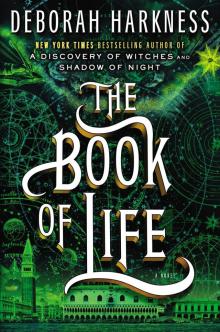 The Book of Life
The Book of Life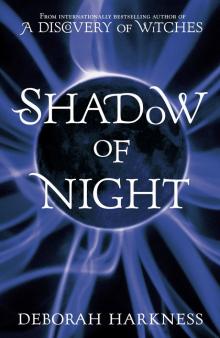 Shadow of Night
Shadow of Night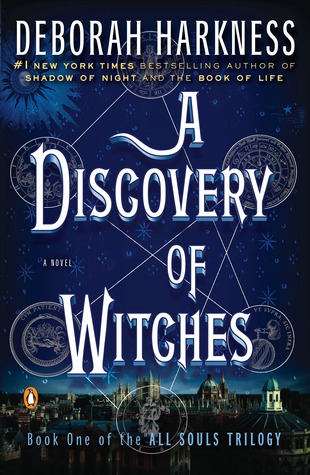 A Discovery of Witches
A Discovery of Witches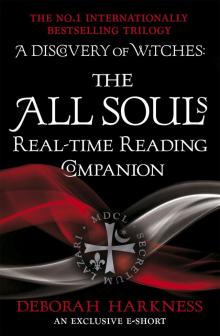 The All Souls Real-Time Reading Companion
The All Souls Real-Time Reading Companion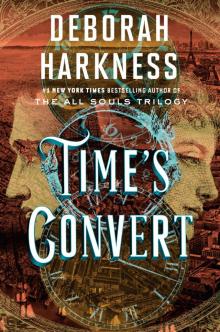 Time's Convert
Time's Convert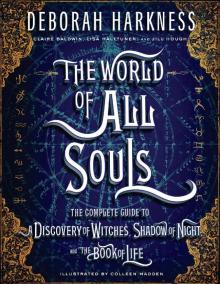 The World of All Souls
The World of All Souls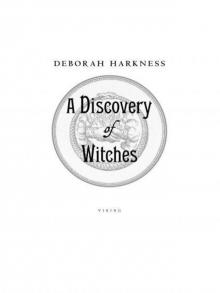 A Discovery of Witches: A Novel (All Souls Trilogy)
A Discovery of Witches: A Novel (All Souls Trilogy) Shadow of Night: A Novel
Shadow of Night: A Novel